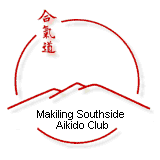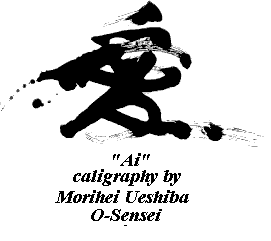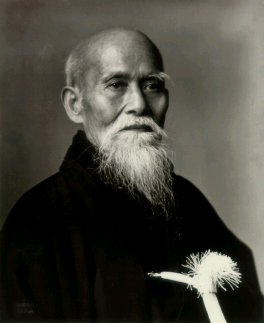 |
Makiling
Southside Aikido Club
Super Bodies Gym, 4/F RFC Shopper's Plaza Las Piñas City, Philippines +63 2 872 63 45 msaikido@hotmail.com |
 |
Makiling
Southside Aikido Club
Super Bodies Gym, 4/F RFC Shopper's Plaza Las Piñas City, Philippines +63 2 872 63 45 msaikido@hotmail.com |
 |
About Aikido About the Founder Upcoming Events Practice Schedule Affiliate Dojo List Pictures Links |
 |
MORIHEI UESHIBA
O-Sensei
 "The victory of Aikido is to strike down and destroy the mind of doubt
and conflict within yourself. It is to realize and carry out the destiny
we have received from divine providence. It is the spirit of universal
protection and nurturing, giving renewed energy to oneself and to others.
This is the true Budo." - Ueshiba Morihei
Founder of Aikido
"The victory of Aikido is to strike down and destroy the mind of doubt
and conflict within yourself. It is to realize and carry out the destiny
we have received from divine providence. It is the spirit of universal
protection and nurturing, giving renewed energy to oneself and to others.
This is the true Budo." - Ueshiba Morihei
Founder of Aikido  As a young man, Morihei Ueshiba (born 14th December 1883) had an unusual
interest in the martial arts, philosophy and religion. The environment
of his youth, one of religious discipline and tradition, had an enormous
effect on the course of his later life.
As a young man, Morihei Ueshiba (born 14th December 1883) had an unusual
interest in the martial arts, philosophy and religion. The environment
of his youth, one of religious discipline and tradition, had an enormous
effect on the course of his later life.The Russo-Japanese War (1904) provided Ueshiba with a real situation to develop himself mentally and physically, in accord with the principles he had learned during his martial arts training. Ueshiba the soldier, spent most of the war years in the harsh climate of Northern Manchuria and by the end of the war, his health had deteriorated considerably. With characteristic vigor, he regained his vitality by the way of long hours spent in outdoor labor. Soon, Ueshiba was engaged by the government to lead a group of immigrants to Hokkaido (the Northern Island of Japan).
 Another
adventurous young man also made the move to Hokkaido, his name was Sokaku
Takeda, head of the Takeda family. Ueshiba and Takeda met in 1905 and Ueshiba
began his study of Daito Ryu Aiki-Jujutsu under Takeda Sensei. In addition,
he continued to practice the other arts he had learned in Tokyo, particularly
Kenjutsu and Jojutsu.
Another
adventurous young man also made the move to Hokkaido, his name was Sokaku
Takeda, head of the Takeda family. Ueshiba and Takeda met in 1905 and Ueshiba
began his study of Daito Ryu Aiki-Jujutsu under Takeda Sensei. In addition,
he continued to practice the other arts he had learned in Tokyo, particularly
Kenjutsu and Jojutsu.
Traveling home to visit his ailing father, Ueshiba met Onisaburo Deguchi, leader of the Omotokyo religion. Ueshiba was very impressed with Deguchi and subsequently became one of his disciples. Although his commitment led him to further develop his mind, his martial arts studies were not neglected. In 1925 Ueshiba organized his own style of Aiki Jujutsu, largely for his own spiritual and physical development.
During the next decade, Ueshiba's students were active in building a foundation for present day Aikido. Ueshiba, however, was interested in seeking the true martial way, the essential spirit of Budo. In his search he left the dojo to work at farming. Through his closeness with nature and continued training, he tried to unify his spiritual and physical being. In 1950, Ueshiba returned to the Tokyo dojo with a mature, modified art which he then called Aikido.
 The evolution
of martial "arts" to "ways", Bugei to Budo. Ueshiba diligently applied
himself to the reworking of the techniques he had taught, and synthesized
them into a form that taught harmony and love rather than violence and
decimation. In this way he was able to integrate his spiritual beliefs
and his great technical proficiency.
The evolution
of martial "arts" to "ways", Bugei to Budo. Ueshiba diligently applied
himself to the reworking of the techniques he had taught, and synthesized
them into a form that taught harmony and love rather than violence and
decimation. In this way he was able to integrate his spiritual beliefs
and his great technical proficiency.
Ueshiba proclaimed that the true Budo way (the way of the warrior) was the way of peaceful reconciliation. He dedicated himself to the design of an art that would teach technical prowess and strength, and commitment to the self-discipline needed for personal growth. He dubbed this new form Aikido.
Ueshiba continued to instruct until his death in 1969, earning the respect and admiration of all who met him. Before his death he received a government award as the designer of modern Aikido, and general acclaim for his efforts to bring peace and enlightenment to all. As his concern and energy touched the lives of his students he worked with, several styles of Aikido evolved.